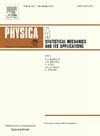Approximate waiting times for queuing systems with variable cross-correlated arrival rates
IF 2.8
3区 物理与天体物理
Q2 PHYSICS, MULTIDISCIPLINARY
Physica A: Statistical Mechanics and its Applications
Pub Date : 2024-10-11
DOI:10.1016/j.physa.2024.130152
引用次数: 0
Abstract
Modern information and telecommunication, transportation and logistic, economic and financial systems are represented by complex networks exhibiting traffic flows with spatio-temporal long-term persistence. Conventional queuing theory relies largely upon stationary models where traffic flows are assumed independent and are typically characterized by the first two moments of inter-arrival and service time distributions, leading to drastic underestimations of traffic flow delays. Here we extend a recent superstatistical approach focusing on traffic models with variable arrival rates by accounting for interdependent activity patterns on multiple network nodes. We suggest an analytical correction to the conventional stationary queue model given by the Kingman’s formula based on the calculation of aggregated inter-arrival times variability from the variabilities of arrival rates at individual nodes and cross-correlations between them. We confirm our analytical approximations by comparing with computer simulation results and large-batch empirical traffic analysis from the backbone of a major academic network. We believe that our results, in combination with recent data on the effects of long-term temporal persistence in network traffic flow, are applicable to various complex networks not limited to information and telecommunication, transportation, and logistics but also to economics and finance, rainfall and river flow dynamics, water accumulation in reservoirs, and many other research domains exhibiting spatio-temporal interdependence patterns.
具有可变交叉相关到达率的排队系统的近似等待时间
现代信息和电信、交通和物流、经济和金融系统由复杂的网络组成,这些网络显示出具有时空长期持续性的交通流。传统的排队理论主要依赖于静态模型,在这些模型中,交通流被假定为独立的,并且通常以到达时间和服务时间分布的前两个时刻为特征,从而导致对交通流延迟的严重低估。在此,我们通过考虑多个网络节点上相互依赖的活动模式,扩展了一种最新的超统计方法,该方法侧重于具有可变到达率的交通模型。我们建议对传统的静止队列模型进行分析修正,该模型由 Kingman 公式给出,基于单个节点到达率的变异性和它们之间的交叉相关性来计算总的到达间隔时间变异性。我们通过与计算机模拟结果和来自一个主要学术网络主干的大批量经验流量分析进行比较,确认了我们的分析近似值。我们相信,结合最近关于网络流量中长期时间持续性影响的数据,我们的结果适用于各种复杂网络,不仅限于信息和电信、交通和物流,还适用于经济和金融、降雨和河流流量动态、水库蓄水以及其他许多表现出时空相互依存模式的研究领域。
本文章由计算机程序翻译,如有差异,请以英文原文为准。
求助全文
约1分钟内获得全文
求助全文
来源期刊
CiteScore
7.20
自引率
9.10%
发文量
852
审稿时长
6.6 months
期刊介绍:
Physica A: Statistical Mechanics and its Applications
Recognized by the European Physical Society
Physica A publishes research in the field of statistical mechanics and its applications.
Statistical mechanics sets out to explain the behaviour of macroscopic systems by studying the statistical properties of their microscopic constituents.
Applications of the techniques of statistical mechanics are widespread, and include: applications to physical systems such as solids, liquids and gases; applications to chemical and biological systems (colloids, interfaces, complex fluids, polymers and biopolymers, cell physics); and other interdisciplinary applications to for instance biological, economical and sociological systems.

 求助内容:
求助内容: 应助结果提醒方式:
应助结果提醒方式:


